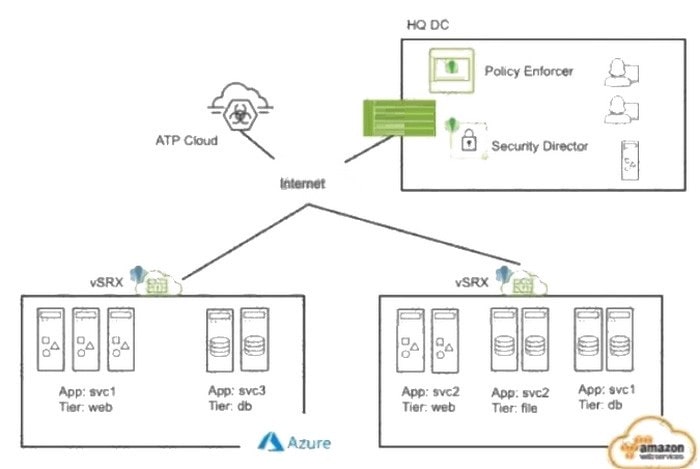Exam Details
Exam Code
:JN0-637Exam Name
:Security, Professional (JNCIP-SEC)Certification
:Juniper CertificationsVendor
:JuniperTotal Questions
:65 Q&AsLast Updated
:Dec 17, 2024
Juniper Juniper Certifications JN0-637 Questions & Answers
-
Question 41:
You configure two Ethernet interfaces on your SRX Series device as Layer 2 interfaces and add them to the same VLAN. The SRX is using the default L2-learning setting. You do not add the interfaces to a security zone.
Which two statements are true in this scenario? (Choose two.)
A. You are unable to apply stateful security features to traffic that is switched between the two interfaces.
B. You are able to apply stateful security features to traffic that enters and exits the VLAN.
C. The interfaces will not forward traffic by default.
D. You cannot add Layer 2 interfaces to a security zone.
-
Question 42:
Referring to the exhibit.

What do you use to dynamically secure traffic between the Azure and AWS clouds?
A. You can dynamically secure traffic between the clouds by using user identities in the security policies.
B. You can dynamically secure traffic between the clouds by using advanced connection tracking in the security policies.
C. You can dynamically secure traffic between the clouds by using security tags in the security policies.
D. You can dynamically secure traffic between the clouds by using URL filtering in the security policies.
-
Question 43:
You have an initial setup of ADVPN with two spokes and a hub. A host at partner Spoke-1 is sending traffic to a host at partner Spoke-2.
In this scenario, which statement is true?
A. Spoke-1 will establish a VPN to Spoke-2 when this is first deployed, so traffic will be sent immediately to Spoke-2.
B. Spoke-1 will send the traffic through the hub and not use a direct VPN to Spoke-2.
C. Spoke-1 will establish the tunnel to Spoke-2 before sending any of the host traffic.
D. Spoke-1 will send the traffic destined to Spoke-2 through the hub until the VPN is established between the spokes.
-
Question 44:
Referring to the exhibit.


Referring to the exhibit, which two statements are correct? (Choose two.)
A. The ge-0/0/3.0 and ge-0/0/4.0 interfaces are not active and will not respond to ARP requests to the virtual IP MAC address.
B. This device is the backup node for SRG1.
C. The ge-0/0/3.0 and ge-0/0/4.0 interfaces are active and will respond to ARP requests to the virtual IP MAC address.
D. This device is the active node for SRG1.
-
Question 45:
You are asked to establish a hub-and-spoke IPsec VPN using an SRX Series device as the hub. All of the spoke devices are third-party devices.
Which statement is correct in this scenario?
A. You must ensure that you are using aggressive mode when incorporating third-party devices as your spokes.
B. You must statically configure the next-hop tunnel binding table entries for each of the third-party spoke devices.
C. You must create a policy-based VPN on the hub device when peering with third-party devices.
D. You must always peer using loopback addresses when using non-Junos devices as your spokes.
-
Question 46:
Referring to the exhibit, which two statements are correct about the NAT configuration? (Choose two.)

A. Both the internal and the external host can initiate a session after the initial translation.
B. Only a specific host can initiate a session to the reflexive address after the initial session.
C. Any external host will be able to initiate a session to the reflexive address.
D. The original destination port is used for the source port for the session.
-
Question 47:
Referring to the exhibit.


In which mode is the SRX Series device?
A. Packet
B. Ethernet switching
C. Mixed
D. Transparent
-
Question 48:
You are asked to create multiple virtual routers using a single SRX Series device. You must ensure that each virtual router maintains a unique copy of the routing protocol daemon (RPD) process.
Which solution will accomplish this task?
A. Secure wire
B. Tenant system
C. Transparent mode
D. Logical system
-
Question 49:
Which two statements are correct about automated threat mitigation with Security Director?(Choose two.)
A. Infected hosts are tracked by their IP address.
B. Infected hosts are tracked by their chassis serial number.
C. Infected hosts are tracked by their MAC address.
D. Infected hosts are tracked by their user identity.
-
Question 50:
You want to deploy two vSRX instances in different public cloud providers to provide redundant security services for your network. Layer 2 connectivity between the two vSRX instances is not possible.
What would you configure on the vSRX instances to accomplish this task?
A. Chassis cluster
B. Secure wire
C. Multinode HA
D. Virtual chassis
Related Exams:
JN0-102
Internet Associate, Junos(JNCIA-Junos)JN0-104
Junos, Associate (JNCIA-Junos)JN0-105
Junos, Associate (JNCIA-Junos)JN0-1101
Juniper Networks Certified Design Associate (JNCDA)JN0-1103
Design, Associate (JNCIA-Design)JN0-130
Juniper networks Certified internet specialist.e(jncis-e)JN0-1301
Data Center Design, Specialist (JNCDS-DC)JN0-1302
Data Center Design Specialist (JNCDS-DC)JN0-1331
Security Design, Specialist (JNCDS-SEC)JN0-1332
Security Design, Specialist (JNCDS-SEC)
Tips on How to Prepare for the Exams
Nowadays, the certification exams become more and more important and required by more and more enterprises when applying for a job. But how to prepare for the exam effectively? How to prepare for the exam in a short time with less efforts? How to get a ideal result and how to find the most reliable resources? Here on Vcedump.com, you will find all the answers. Vcedump.com provide not only Juniper exam questions, answers and explanations but also complete assistance on your exam preparation and certification application. If you are confused on your JN0-637 exam preparations and Juniper certification application, do not hesitate to visit our Vcedump.com to find your solutions here.